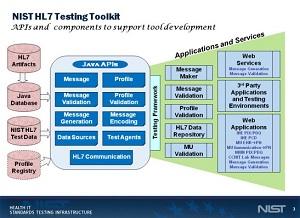Transactional Testing
HIT: Transactional Testing
Overview

Industry Need Addressed
When originally developed, HL7 was designed to accommodate the many diverse processes that exist in the healthcare industry. This universal design was necessary to gain broad industry support. However, this resulted in a standard that could not be sufficiently constrained to provide a single and consistent interpretation – prohibiting plug and play installations. As a consequence, systems are difficult to implement and debug resulting in undue costs. To help alleviate this shortcoming the concept of message profiles were introduced. A message profile is a proper subset of the HL7 messaging standard that constricts the definition of a message in a manner that specifically states the optional constructs and processing rules of a message. However, if the profile rules are not followed, then interoperability problems will still persist.Conformance testing is essential. NIST is developing testing tools to ensure that message profiles are applied as intended to fulfill the promise of interoperable healthcare systems.
NIST/ITL Approach
The introduction of message profiles to the HL7 standard provides a path to conformance and interoperability testing. NIST is building a tool kit that supports the testing of HL7 message interfaces based on the concept of message profiles. The foundation of the tool kit is a set of Java APIs and testing framework that supports testing activities such as automated message generation, message validation, and use case testing. The toolkit can be used to build tools, web services, or they can be incorporated into 3rd party applications and testing environments. Using the toolkit, NIST has developed numerous tools including Meaningful Use Certification Tools, IHE V2/V3 PIX/PDQ and V2 PCD Pre-connectathon and Connectathon tools, Message Maker, and productivity tools for supporting implementation guides and test case development. The toolkit's roots and main focus is on HL7 v2; however, recently the toolkit has added capabilities to support v3 validation. Tools are delivered as standalone applications, web services, and web applications.
Impact
There is strong consensus that standards-based messaging, using the HL7 standards, is the key for the US to reap the benefits of an electronic healthcare infrastructure.However achieving true interoperability, by implementing HL7 within all of the healthcare sectors (e.g., outpatient, ambulatory, and long-term care) may prove cost prohibitive.Developing a testing infrastructure to build test tools will lead to a stronger set of conformance tests and tools which will reduce the cost of achieving interoperability.

